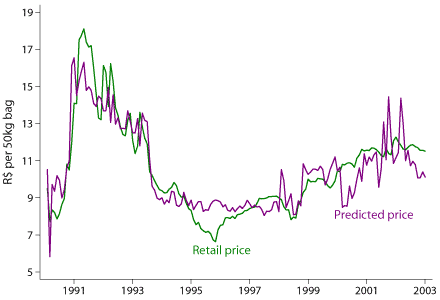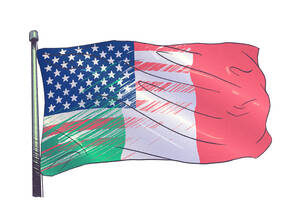During the summer of 2007, a couple of months after finishing a draft of a paper on the Brazilian cement industry, Alberto Salvo, Assistant Professor of Management and Strategy, received a phone call from Elizabeth Farina, President of Brazil’s Administrative Council for Economic Defense, an antitrust authority that is part of the Ministry of Justice. An economist herself and a Professor at the Universidade de São Paulo, Farina was frustrated with what she considered the misapplication of an econometric technique used to test companies for anti-competitive behavior. She specifically cited the case of an industry (unrelated to cement) charged by the Brazilian competition authorities with price-fixing. The government had gathered substantial direct evidence—the so-called “smoking gun”—against the alleged cartel, including records of private meetings among executives of the different firms, other company documents, and testimony by whistleblowers. Yet, in the course of the legal proceedings, consulting firms hired by the defendants had presented statistical tests they claimed proved their clients enjoyed no market power and, hence, were behaving in “perfect competition.” Recalling a 2004 talk he had given regarding the unreliability of these kinds of statistical tests, Farina asked Professor Salvo to write a policy document which could help her with this current case.
Curtailing anti-competitive behavior has long been a major concern of economic policymakers. By attempting to limit companies’ use of illegally obtained market power, antitrust authorities hope to make markets work more efficiently, thereby allowing a greater number of consumers to participate as competition drives prices down. The crucial issue for antitrust authorities, then, is how to measure “market power,” also known as “price minus (economic) cost margin,” where the costs considered are economic costs rather than book values. Higher price-cost margins in an industry reflect more market power. Thus, if trustbusters find low price-cost margins in an industry where firms are suspected of collusion, they can shift their enforcement and monitoring resources elsewhere.
Unfortunately, it is difficult for an antitrust policy analyst to track price-cost margins; although prices typically are publicly available, companies keep cost information private. Economists have developed an econometric technique that attempts to infer price-cost margins—that is, the degree of market power—from more easily accessible data such as prices and quantities of goods sold, and market conditions external to the industry (e.g., whether climatic conditions or seasonality alters the demand for the industry’s output or the cost of the industry’s inputs). Ideally, the technique works in the following way: Imagine a hypothetical ice-cream industry. When temperatures rise in the summer, consumers demand more ice cream and become less sensitive to price. Suppose also that the cost of the industry’s inputs, such as milk, does not rise in the summer. Although prices might not change much in a competitive industry, a group of companies with market power in that industry (a cartel, for example) might exploit the fact that consumers’ demands have suddenly become less elastic and the cartel might raise prices considerably. By observing the extent to which ice-cream prices increase in the summer, the policy analyst tries to estimate the degree of market power enjoyed by ice-cream companies.
The validity of the supporting theoretical model is key to the success of this technique. Salvo argues that, in practice, pricing decisions made by firms often are more complex than those offered in the model. Suppose this hypothetical ice-cream industry is, indeed, cartelized and enjoys significant market power—with prices far exceeding costs. But now suppose the industry is aware that were it to raise prices beyond a certain threshold, it would also raise suspicions and invite unwanted antitrust scrutiny. Or suppose that—already enjoying high margins—the ice-cream cartel were to further raise prices, many less-efficient outside firms would hasten to enter the industry. Under these circumstances, the ice-cream cartel might decide not to raise prices in the manner predicted by the theoretical model, even in an unusually hot summer. In other words, potential scrutiny by regulators or the threat of entry by other firms might work as latent price ceilings. Because the prices observed are censored, the analyst who is using the technique might underestimate the correct price-cost margins the cartel enjoys. He might wrongly assume the lack of price variation in the summer to be evidence of competition and of costs close to prices.
In the language of statistics, the power of such a test is low. The policy analyst might falsely infer that margins are low when actually they are high. Assuming that margins are low, the analyst might refrain from filing an antitrust case, enabling the hypothetical ice-cream cartel to get away with the collusion that allows it to sustain substantial price-cost margins. Society would be prevented from consuming more ice cream, which could still be profitably produced.
In his 2007 working paper, Salvo illustrates the econometric bias in the application of this technique by examining an industry that he claims has operated as a real-world cartel: the Brazilian cement industry, using data from 1991 through 2003. By 1999 Brazil was the sixth largest cement producer in the world, with fifty-seven operating plants scattered in an area slightly smaller than the United States, although concentrated mostly in coastal states. The industry was also concentrated, with twelve firms in 1999, down from nineteen in 1991. The largest producers, in terms of nationwide shipment shares, were Votorantim (41%) followed by Grupo João Santos (12%), Holcim (9%), and Lafarge (8%). Cement has a very short shelf life and, like in other developing countries, producers shipped 80 percent of volume in bags to resellers, who then sold to small scale consumers. The remaining 20 percent was shipped in bulk directly to customers such as ready-mix concrete firms or large construction firms.
Salvo’s research suggests that this industry faced the threat of import competition. Figure 1 shows that imports of cement and clinker (the main component in ordinary cement) between 1989 and 2003 have amounted to no more than 2-3 percent of total consumption. This fact was a striking when compared to the United States, where imports were as high as 30 percent of consumption in coastal markets. This low level of imports masked the true disciplining power they had on prices in the Brazilian market. The domestic cement oligopoly surely set high prices, but not too high such that imports were just priced out of the market.
Figure 1: Imports as a percentage of consumption
One way of seeing this is through a linear regression of the domestic retail cement price on a series of variables that determine the cost of imported cement such as the exchange rate, the world price of oil, and an index of maritime freight costs, among others. This regression explains up to 72 percent of the variation in the domestic retail price of cement. Figure 2 plots the retail price in São Paulo for a standard 50kg bag against the predicted values from the regression, showing that the fit is very good. Among other pieces of evidence, Salvo also highlighted that when he looked at retail cement prices at the local market level, the further away the market was from the country’s long coastline, the higher the price of cement was. Prices were consistently higher in the “jungle” states than in coastal states.
Figure 2: Retail cement price in the state of São Paulo compared to price predicted by determinants of the cost of imported cement
Thus, although it may seem that imports played a limited role in this industry, Salvo found that the threat of foreign entry placed a ceiling on domestic prices. To show how the econometric market power technique might not work in practice, Salvo conducted the following exercise: Suppose a policy analyst implemented the traditional technique in order to estimate the domestic cement industry’s margins. The analyst, unaware of the latent role of imports, might overlook the fact that the underlying theoretical model on which the technique rests does not allow for the constraining effect of the threat of entry on prices. By observing that cement prices rise little when, say, the economy booms and the demand for construction goes up, the analyst might conclude that the domestic cement industry is competitive and that price-cost margins are low. Indeed, by implementing the established technique, the price-cost margins per 50 kg bag appear to be negligible.
Thanks to the cement industry’s simple technology and to his many years of collecting data and talking to industry insiders, Professor Salvo was in the rare position of being able to observe industry costs and to check the estimated margins. He has determined that the true price-cost margins were far from being competitive, averaging 4 reais per bag in December 1999 prices or about US$2.70 /bag, at current prices. This is equivalent to approximately 50 percent of net producer prices.
Salvo’s translated his insights about the pitfalls of estimating price-cost margins into a policy paper for Elizabeth Farina’s Administrative Council for Economic Defense. He has presented this work in various seminars in Brazil, Europe, and the North America, including the U.S.’s National Bureau of Economic Research Industrial Organization summer meeting, and the working paper has also garnered him a prize from the Brazilian Ministry of the Treasury’s Secretariat for Economic Monitoring in November 2007.
In further research on the Brazilian cement industry, Salvo explored the cartel’s spatial supply arrangement, showing how, whether tacitly or explicitly, firms divide geographic markets among themselves. For example, looking at two small neighboring states in Brazil’s northeast, Alagoas and Sergipe, Salvo’s data indicated that in 1996, Brennand Cimentos (later acquired by Cimpor) had a market share of 83 percent in the state of Alagoas, where it had one plant, but realized no sales in the neighboring state of Sergipe. In contrast, Votorantim Cimentos had a market share of 89 percent in Sergipe, where it had a plant, but only a 7 percent share of the Alagoas market. Based on his measures of marginal cost, selling cement in the neighboring state would have been very profitable (in an immediate sense) for both firms. Salvo suggested that the absence of sales in the neighboring state was consistent with a multimarket agreement, where a firm restricted supply from a plant to the neighboring markets no matter how profitable it would have been to serve those other markets. In return, other companies located in these neighboring markets agreed to stay away from the first firm’s home turf. Tellingly, while Brennand chose not to sell any cement in Sergipe, it did do so in the other neighboring states: Paraíba, Bahia and Pernambuco.
Salvo’s work on the Brazilian cement industry highlights a major benefit of globalization, an issue he is now delving into with data from the U.S. cement industry. “People talk about globalization when they see imports or factories relocating abroad,” says Salvo. “However, that is just the tip of the iceberg— equally, if not more important, is the invisible threat of imports or relocation that disciplines the prices of certain goods and kinds of labor.” A clear policy recommendation would be to further reduce the transaction costs for imports, thus curbing the substantial market power that domestic producers might wield in certain industries. In the Brazilian cement industry, this recommendation would lead to lower prices rather than to increased imports, significantly benefiting consumers and helping to tackle the country’s huge housing deficit and its infrastructure needs. Nevertheless, as recently as 2000 (extended for five additional years in 2006), the Brazilian cement industry succeeded in lobbying the government to enact anti-dumping measures against Mexican and Venezuelan producers. It might be simply too early for Alberto Salvo’s research to have an impact on the work of consultants and regulators, but the Brazilian government seems receptive and his students are learning about it.
Further reading:
Corts, Kenneth S. (1999). “Conduct parameters and the measurement of market power.” Journal of Econometrics, 88(2): 227-250.
Salvo, Alberto. 2010. “Inferring Market Power under the Threat of Entry: The Case of the Brazilian Cement Industry.” RAND Journal of Economics 41(2): 326-350.
Salvo, Alberto. 2010. “Trade Flows in a Spatial Oligopoly: Gravity Fits Well, But What Does it Explain?” Canadian Journal of Economics 43 (1): 63-96.


